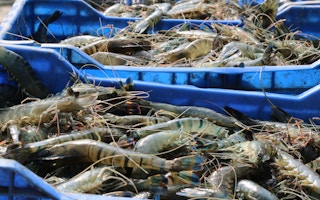For nearly 50 years, commercial shrimp farming has led to short-term economic gains for Bangladesh. But, combined with the impacts of climate change, it is now proving disastrous for the environment and communities. The delta nation faces a projected 50 cm of sea level rise by 2050, a change that will affect the increasingly populous coasts where people continue to migrate despite growing environmental hazards.
For Bangladesh, sea level rise means not only significant loss of land, but also loss of livelihoods as saltwater infiltrates streams and bodies of water that previously sustained crops, livestock and people. The threat of climate change adds to the impacts of intensive aquaculture. Over the decades, shrimp farms have artificially enhanced the penetration of saltwater.
Between 1973 and 2012, income from exports of shrimp rose from USD 2.9 million to a peak of USD 590 million. The industry boomed after Bangladesh’s independence in 1971, with businesses flocking to the promising new market.
Mohammad Aftabuzzaman, former fisheries minister, tells The Third Pole: “I became the minister for fisheries in 1980 and included commercial shrimp cultivation as official [policy], as our government believed that by exporting shrimp the country could boost its economy. And later our projection came true.”
But since then, earnings have been decreasing. Shrimp yields are in decline due to the spread of disease, a common occurrence in intensive farming.
While yields and profits have started to dwindle, large-scale shrimp cultivation has raised the salinity of soil, ponds, rivers and other water bodies, especially in the coastal region of southwestern Bangladesh.
To create the conditions required by shrimp, farmland was altered where rice was once grown. The saline water that shrimp need was let into the farms, sometimes by damaging the embankments that used to protect the paddies, freshwater ponds and homes, says Ahsan Uddin Ahmed, executive director of the think tank Centre for Global Change.
According to the Bangladesh Frozen Foods Exporters Association (BFFEA), today shrimp are being cultivated in 276,000 hectares of the 337,164 hectares of land available along the coast, or 81 per cent. Of them, 195,000 hectares or 76 per cent are in Satkhira, Khulna and Bagerhat districts.
Farmers pushed towards shrimp cultivation
As shrimp farms surrounded smallholdings, the saline water leached into their land. This killed the rice plants in the paddies, even when the embankments were not deliberately damaged. Gradually, most farmers moved from rice to shrimp cultivation, many in the hope of making more money, some because they had no choice.
In the village of Shoilkhali in Satkhira district, Mohammad Abdul Jalil, now 62, was the last farmer of his community to turn shrimp cultivator. Jalil told The Third Pole: “I was forced to shift to shrimp farming on my eight acres about 25 years back [in the late 1990s] because all the land surrounding my fields went under shrimp cultivation. Naturally, my farm also turned saline.”
Syeda Rizwana Hasan, chief executive of the Bangladesh Environmental Lawyers Association, said: “Since the beginning, the sector has been promoted by violating rights of the locals.”
“Influential people started the cultivation,” she explained, then a growing number of smallholders, previously happy with cultivating paddy, were drawn to shrimp farming in the hope of increasing their profits. Others, Hasan said, were forced to switch as their land became saline due to surrounding shrimp farms.
Impacts of shrimp farming
Khairul Islam, regional director of WaterAid South Asia, said that “the coastal water was never as saline as it is today”. Over many years of work along the Bangladeshi coasts, he explained, “we have seen that where there is shrimp culture, the freshwater crisis is more acute”.
Ponds are the major source of freshwater in rural Bangladesh. When farms nearby turn saline due to shrimp aquaculture, brackish water seeps into the ground and contaminates the ponds, which become saline as well, Islam said.
A 2019 study by WaterAid Bangladesh looked at 57 ponds in the Shyamnagar sub-district of Satkhira district, and found that the water in 16 of them was too salty to drink or be used for cooking; in 25 others, it was still too salty to drink, though it could be used for cooking. And 14 other ponds were out of bounds to residents because they were being used for shrimp aquaculture. Islam said the situation is similar in Khulna and Bagerhat districts.
As freshwater scarcity worsens, coastal residents now collect as much rainwater as they can during the June-September monsoon and eke it out for as long as they can. Then they buy drinking water at 40 times the price that residents in capital Dhaka pay.
“During the rainy season we collected water from our own harvesting pots for drinking,” said 50-year-old Suvodra Mondol, a resident of the Durgabati village in Shyamnagar sub-district. “Our priority is to collect some potable water first. For the rest of our work, we use water from ponds and canals, whether saline or not.”
When buying water, Mondol rents a vehicle to cart the water home. Each journey takes about two hours.
Ainun Nishat, a hydrologist and environmental expert, pointed out that many people in poor households tend to drink as little water as possible in the dry months, and this has serious health consequences.
Shyamnagar’s MP Jaglul Haider agreed that potable water scarcity is increasing due to shrimp aquaculture. At the same time, the MP said, “We can’t avoid shrimp as this is one of the major export items and earns a good amount of money.” Haider has said on record that he owns shrimp aquaculture farms himself.
This story was published with permission from The Third Pole.








